ACC2360 Team Report: Managerial Accounting Case Study
VerifiedAdded on 2022/09/07
|9
|1910
|19
Report
AI Summary
This report provides a comprehensive analysis of Woolworths, a leading retail company, through the lens of managerial accounting. It begins with an environmental analysis using SWOT and PESTLE frameworks to understand the company's strengths, weaknesses, opportunities, and threats, as well as the political, economic, social, technological, legal, and environmental factors impacting its operations. Based on this analysis, the report recommends strategic approaches, primarily focusing on a cost leadership strategy complemented by a differentiation focus to enhance market share and profitability, especially in the context of expanding into developing countries and offering organic product lines. The report then constructs a Balanced Scorecard, outlining strategic objectives across financial, customer, internal business processes, and learning and growth perspectives, along with key performance indicators (KPIs) to measure progress. The financial objectives center on cost reduction and profit margin improvement, while the customer perspective emphasizes market share and organic product adoption. Internal processes focus on innovation and efficiency, and learning and growth emphasizes employee training and development. The conclusion summarizes the key findings and recommendations, emphasizing the importance of adapting to competitive pressures and leveraging strategic tools for sustainable growth.
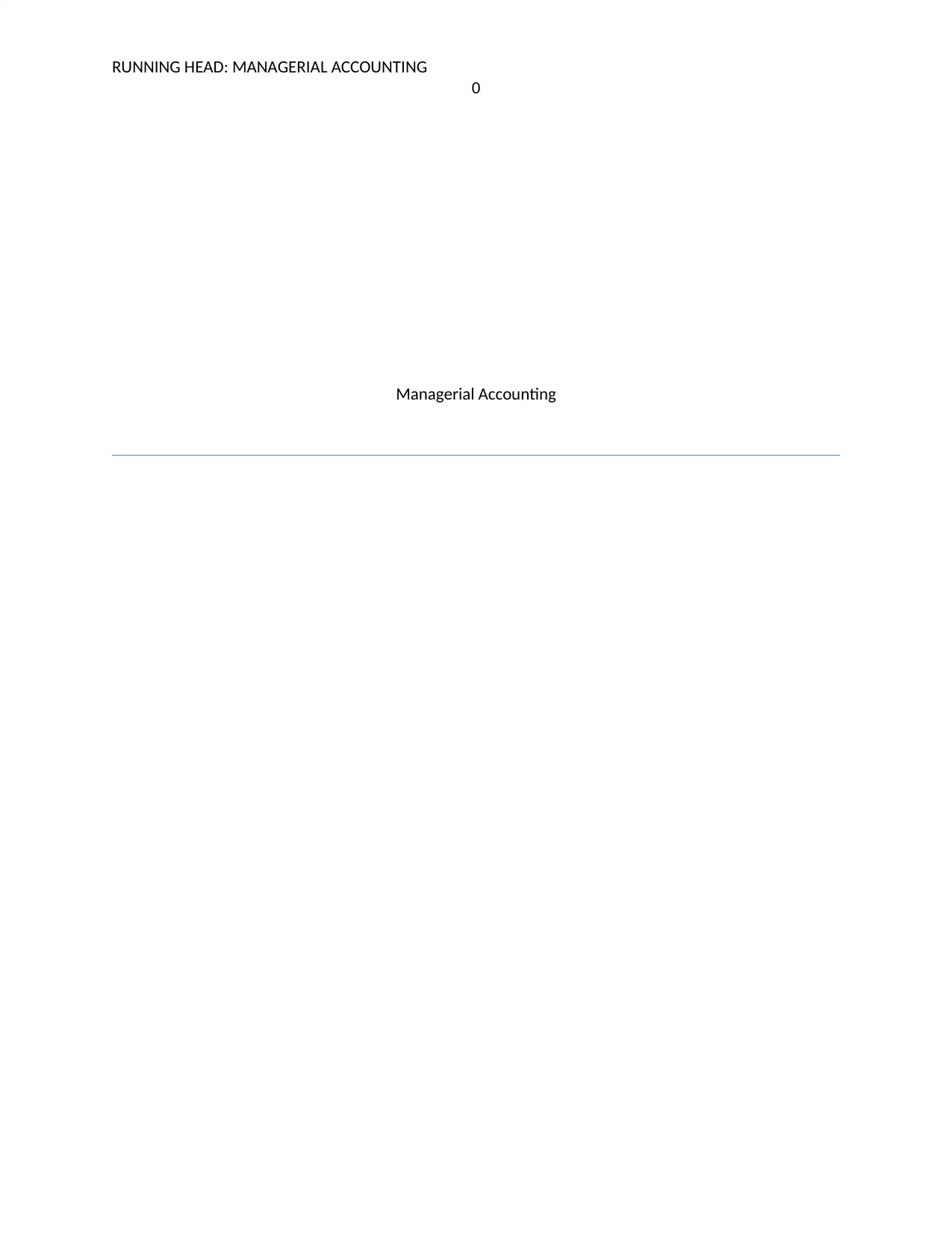
RUNNING HEAD: MANAGERIAL ACCOUNTING
0
Managerial Accounting
0
Managerial Accounting
Paraphrase This Document
Need a fresh take? Get an instant paraphrase of this document with our AI Paraphraser
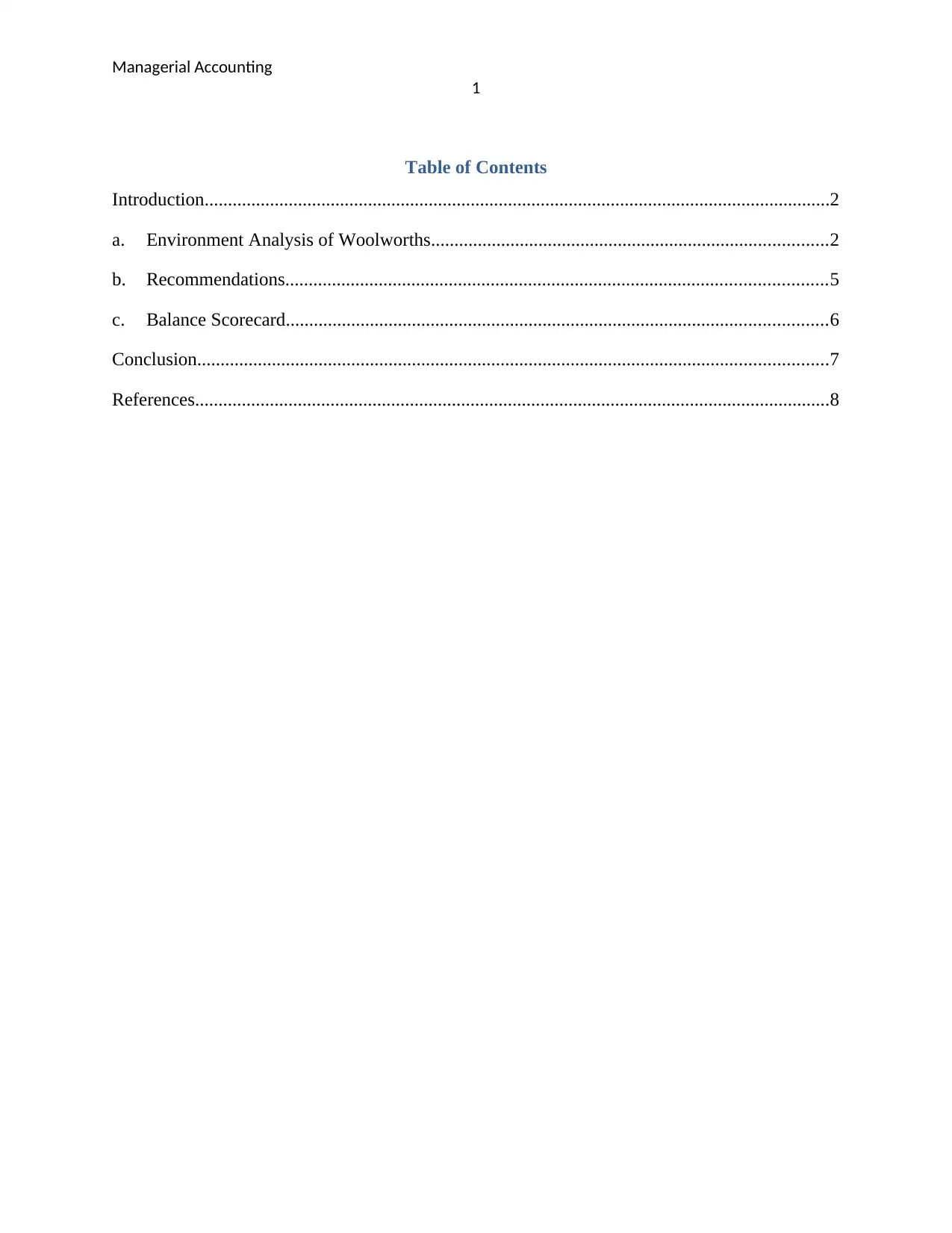
Managerial Accounting
1
Table of Contents
Introduction......................................................................................................................................2
a. Environment Analysis of Woolworths.....................................................................................2
b. Recommendations....................................................................................................................5
c. Balance Scorecard....................................................................................................................6
Conclusion.......................................................................................................................................7
References........................................................................................................................................8
1
Table of Contents
Introduction......................................................................................................................................2
a. Environment Analysis of Woolworths.....................................................................................2
b. Recommendations....................................................................................................................5
c. Balance Scorecard....................................................................................................................6
Conclusion.......................................................................................................................................7
References........................................................................................................................................8
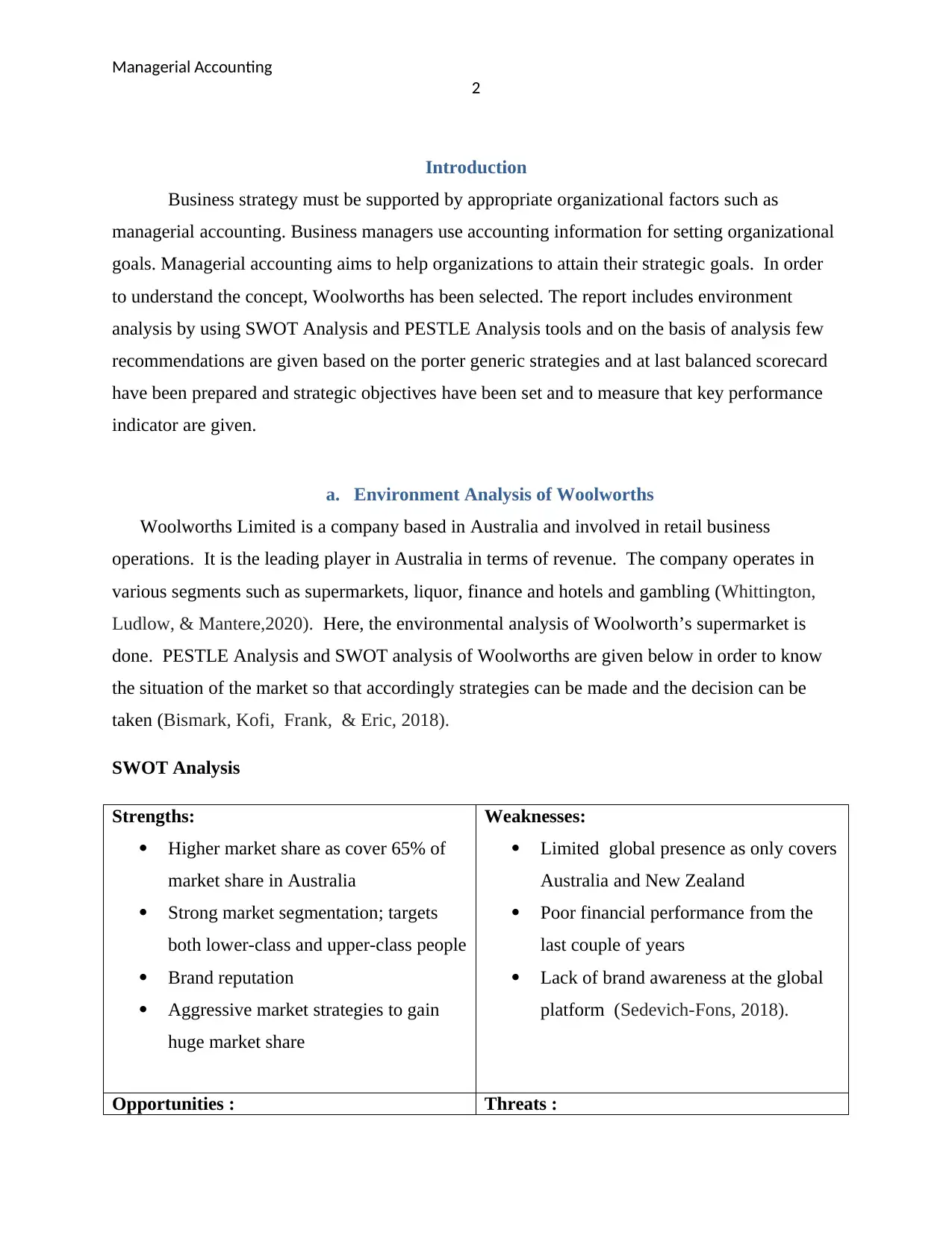
Managerial Accounting
2
Introduction
Business strategy must be supported by appropriate organizational factors such as
managerial accounting. Business managers use accounting information for setting organizational
goals. Managerial accounting aims to help organizations to attain their strategic goals. In order
to understand the concept, Woolworths has been selected. The report includes environment
analysis by using SWOT Analysis and PESTLE Analysis tools and on the basis of analysis few
recommendations are given based on the porter generic strategies and at last balanced scorecard
have been prepared and strategic objectives have been set and to measure that key performance
indicator are given.
a. Environment Analysis of Woolworths
Woolworths Limited is a company based in Australia and involved in retail business
operations. It is the leading player in Australia in terms of revenue. The company operates in
various segments such as supermarkets, liquor, finance and hotels and gambling (Whittington,
Ludlow, & Mantere,2020). Here, the environmental analysis of Woolworth’s supermarket is
done. PESTLE Analysis and SWOT analysis of Woolworths are given below in order to know
the situation of the market so that accordingly strategies can be made and the decision can be
taken (Bismark, Kofi, Frank, & Eric, 2018).
SWOT Analysis
Strengths:
Higher market share as cover 65% of
market share in Australia
Strong market segmentation; targets
both lower-class and upper-class people
Brand reputation
Aggressive market strategies to gain
huge market share
Weaknesses:
Limited global presence as only covers
Australia and New Zealand
Poor financial performance from the
last couple of years
Lack of brand awareness at the global
platform (Sedevich-Fons, 2018).
Opportunities : Threats :
2
Introduction
Business strategy must be supported by appropriate organizational factors such as
managerial accounting. Business managers use accounting information for setting organizational
goals. Managerial accounting aims to help organizations to attain their strategic goals. In order
to understand the concept, Woolworths has been selected. The report includes environment
analysis by using SWOT Analysis and PESTLE Analysis tools and on the basis of analysis few
recommendations are given based on the porter generic strategies and at last balanced scorecard
have been prepared and strategic objectives have been set and to measure that key performance
indicator are given.
a. Environment Analysis of Woolworths
Woolworths Limited is a company based in Australia and involved in retail business
operations. It is the leading player in Australia in terms of revenue. The company operates in
various segments such as supermarkets, liquor, finance and hotels and gambling (Whittington,
Ludlow, & Mantere,2020). Here, the environmental analysis of Woolworth’s supermarket is
done. PESTLE Analysis and SWOT analysis of Woolworths are given below in order to know
the situation of the market so that accordingly strategies can be made and the decision can be
taken (Bismark, Kofi, Frank, & Eric, 2018).
SWOT Analysis
Strengths:
Higher market share as cover 65% of
market share in Australia
Strong market segmentation; targets
both lower-class and upper-class people
Brand reputation
Aggressive market strategies to gain
huge market share
Weaknesses:
Limited global presence as only covers
Australia and New Zealand
Poor financial performance from the
last couple of years
Lack of brand awareness at the global
platform (Sedevich-Fons, 2018).
Opportunities : Threats :
⊘ This is a preview!⊘
Do you want full access?
Subscribe today to unlock all pages.

Trusted by 1+ million students worldwide
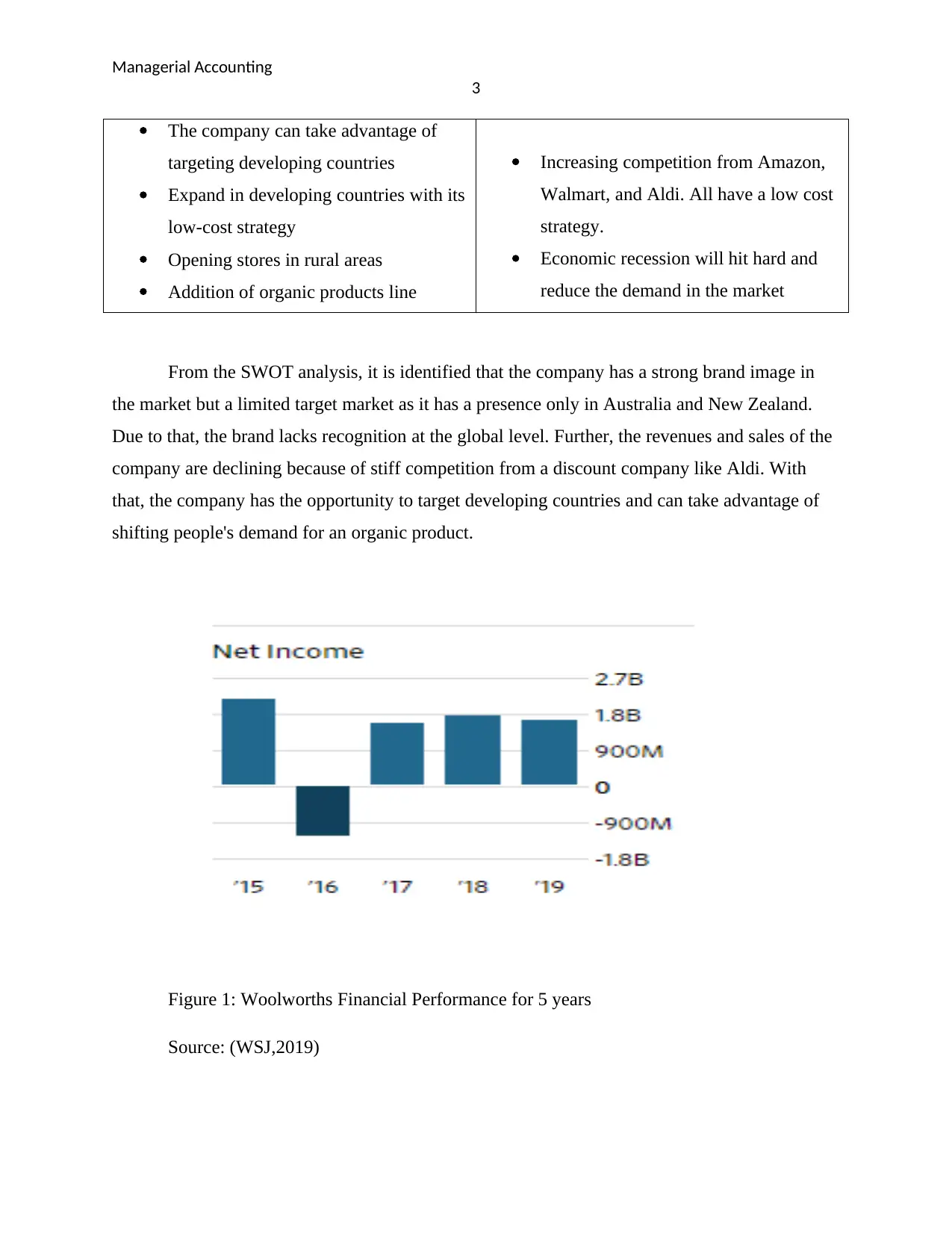
Managerial Accounting
3
The company can take advantage of
targeting developing countries
Expand in developing countries with its
low-cost strategy
Opening stores in rural areas
Addition of organic products line
Increasing competition from Amazon,
Walmart, and Aldi. All have a low cost
strategy.
Economic recession will hit hard and
reduce the demand in the market
From the SWOT analysis, it is identified that the company has a strong brand image in
the market but a limited target market as it has a presence only in Australia and New Zealand.
Due to that, the brand lacks recognition at the global level. Further, the revenues and sales of the
company are declining because of stiff competition from a discount company like Aldi. With
that, the company has the opportunity to target developing countries and can take advantage of
shifting people's demand for an organic product.
Figure 1: Woolworths Financial Performance for 5 years
Source: (WSJ,2019)
3
The company can take advantage of
targeting developing countries
Expand in developing countries with its
low-cost strategy
Opening stores in rural areas
Addition of organic products line
Increasing competition from Amazon,
Walmart, and Aldi. All have a low cost
strategy.
Economic recession will hit hard and
reduce the demand in the market
From the SWOT analysis, it is identified that the company has a strong brand image in
the market but a limited target market as it has a presence only in Australia and New Zealand.
Due to that, the brand lacks recognition at the global level. Further, the revenues and sales of the
company are declining because of stiff competition from a discount company like Aldi. With
that, the company has the opportunity to target developing countries and can take advantage of
shifting people's demand for an organic product.
Figure 1: Woolworths Financial Performance for 5 years
Source: (WSJ,2019)
Paraphrase This Document
Need a fresh take? Get an instant paraphrase of this document with our AI Paraphraser
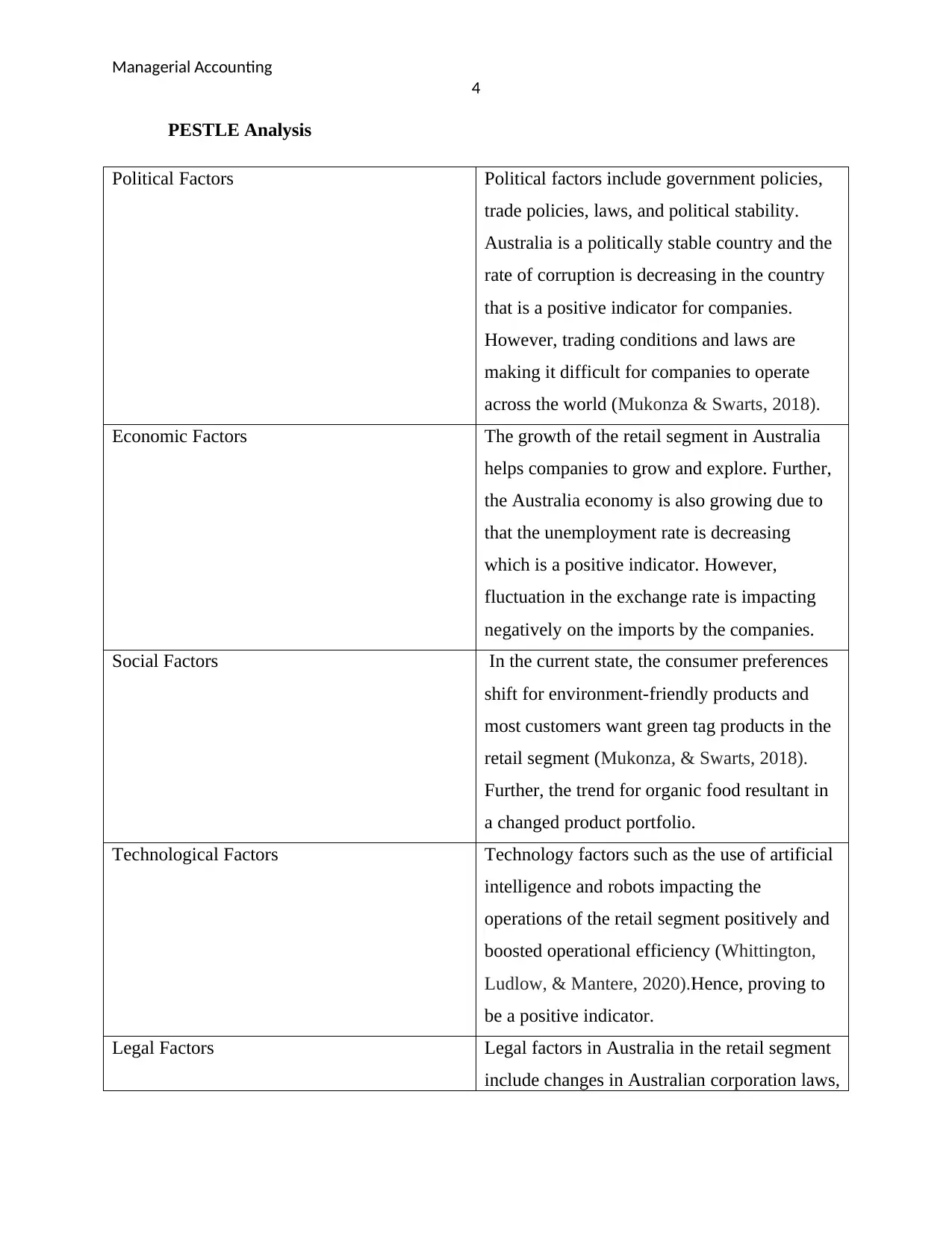
Managerial Accounting
4
PESTLE Analysis
Political Factors Political factors include government policies,
trade policies, laws, and political stability.
Australia is a politically stable country and the
rate of corruption is decreasing in the country
that is a positive indicator for companies.
However, trading conditions and laws are
making it difficult for companies to operate
across the world (Mukonza & Swarts, 2018).
Economic Factors The growth of the retail segment in Australia
helps companies to grow and explore. Further,
the Australia economy is also growing due to
that the unemployment rate is decreasing
which is a positive indicator. However,
fluctuation in the exchange rate is impacting
negatively on the imports by the companies.
Social Factors In the current state, the consumer preferences
shift for environment-friendly products and
most customers want green tag products in the
retail segment (Mukonza, & Swarts, 2018).
Further, the trend for organic food resultant in
a changed product portfolio.
Technological Factors Technology factors such as the use of artificial
intelligence and robots impacting the
operations of the retail segment positively and
boosted operational efficiency (Whittington,
Ludlow, & Mantere, 2020).Hence, proving to
be a positive indicator.
Legal Factors Legal factors in Australia in the retail segment
include changes in Australian corporation laws,
4
PESTLE Analysis
Political Factors Political factors include government policies,
trade policies, laws, and political stability.
Australia is a politically stable country and the
rate of corruption is decreasing in the country
that is a positive indicator for companies.
However, trading conditions and laws are
making it difficult for companies to operate
across the world (Mukonza & Swarts, 2018).
Economic Factors The growth of the retail segment in Australia
helps companies to grow and explore. Further,
the Australia economy is also growing due to
that the unemployment rate is decreasing
which is a positive indicator. However,
fluctuation in the exchange rate is impacting
negatively on the imports by the companies.
Social Factors In the current state, the consumer preferences
shift for environment-friendly products and
most customers want green tag products in the
retail segment (Mukonza, & Swarts, 2018).
Further, the trend for organic food resultant in
a changed product portfolio.
Technological Factors Technology factors such as the use of artificial
intelligence and robots impacting the
operations of the retail segment positively and
boosted operational efficiency (Whittington,
Ludlow, & Mantere, 2020).Hence, proving to
be a positive indicator.
Legal Factors Legal factors in Australia in the retail segment
include changes in Australian corporation laws,
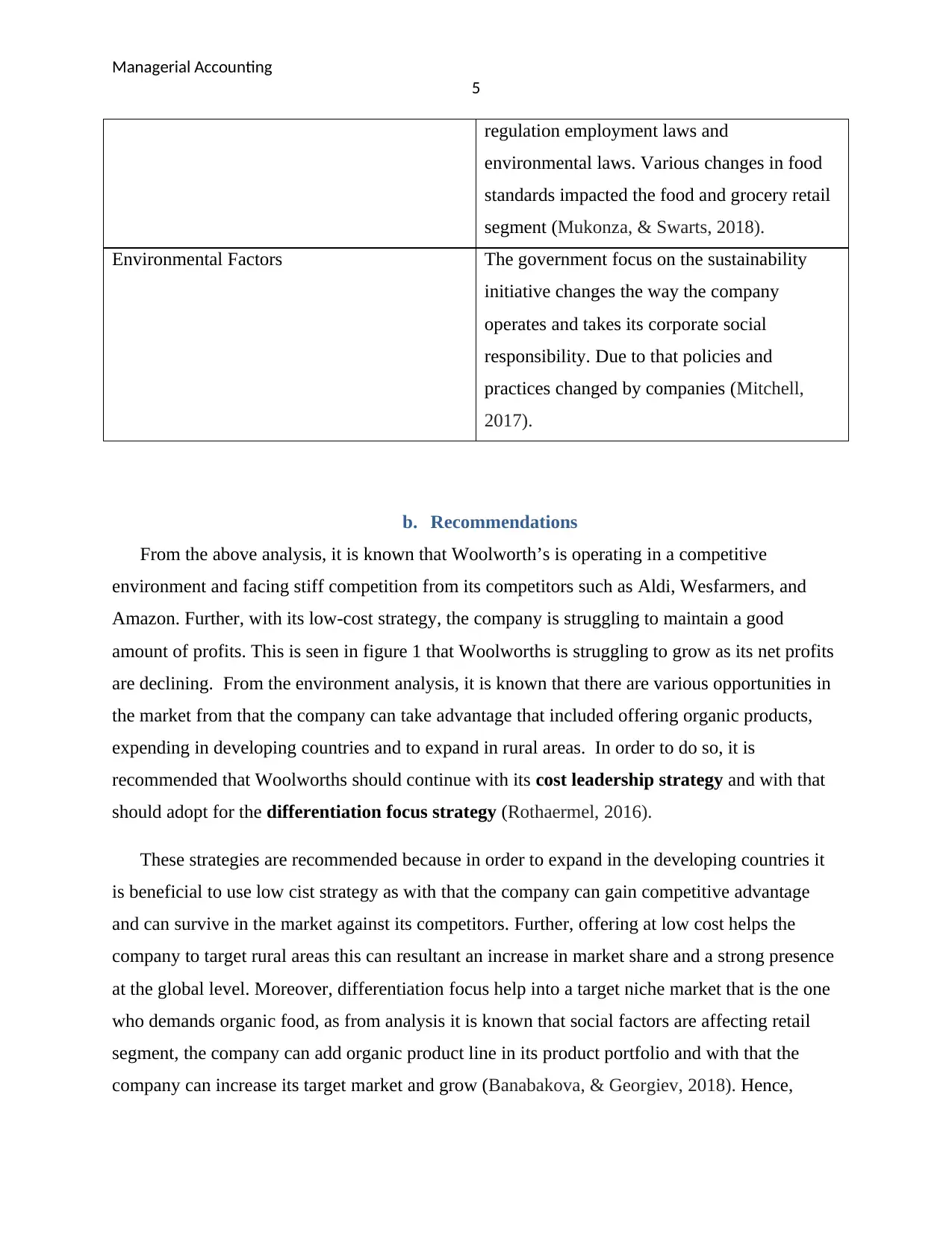
Managerial Accounting
5
regulation employment laws and
environmental laws. Various changes in food
standards impacted the food and grocery retail
segment (Mukonza, & Swarts, 2018).
Environmental Factors The government focus on the sustainability
initiative changes the way the company
operates and takes its corporate social
responsibility. Due to that policies and
practices changed by companies (Mitchell,
2017).
b. Recommendations
From the above analysis, it is known that Woolworth’s is operating in a competitive
environment and facing stiff competition from its competitors such as Aldi, Wesfarmers, and
Amazon. Further, with its low-cost strategy, the company is struggling to maintain a good
amount of profits. This is seen in figure 1 that Woolworths is struggling to grow as its net profits
are declining. From the environment analysis, it is known that there are various opportunities in
the market from that the company can take advantage that included offering organic products,
expending in developing countries and to expand in rural areas. In order to do so, it is
recommended that Woolworths should continue with its cost leadership strategy and with that
should adopt for the differentiation focus strategy (Rothaermel, 2016).
These strategies are recommended because in order to expand in the developing countries it
is beneficial to use low cist strategy as with that the company can gain competitive advantage
and can survive in the market against its competitors. Further, offering at low cost helps the
company to target rural areas this can resultant an increase in market share and a strong presence
at the global level. Moreover, differentiation focus help into a target niche market that is the one
who demands organic food, as from analysis it is known that social factors are affecting retail
segment, the company can add organic product line in its product portfolio and with that the
company can increase its target market and grow (Banabakova, & Georgiev, 2018). Hence,
5
regulation employment laws and
environmental laws. Various changes in food
standards impacted the food and grocery retail
segment (Mukonza, & Swarts, 2018).
Environmental Factors The government focus on the sustainability
initiative changes the way the company
operates and takes its corporate social
responsibility. Due to that policies and
practices changed by companies (Mitchell,
2017).
b. Recommendations
From the above analysis, it is known that Woolworth’s is operating in a competitive
environment and facing stiff competition from its competitors such as Aldi, Wesfarmers, and
Amazon. Further, with its low-cost strategy, the company is struggling to maintain a good
amount of profits. This is seen in figure 1 that Woolworths is struggling to grow as its net profits
are declining. From the environment analysis, it is known that there are various opportunities in
the market from that the company can take advantage that included offering organic products,
expending in developing countries and to expand in rural areas. In order to do so, it is
recommended that Woolworths should continue with its cost leadership strategy and with that
should adopt for the differentiation focus strategy (Rothaermel, 2016).
These strategies are recommended because in order to expand in the developing countries it
is beneficial to use low cist strategy as with that the company can gain competitive advantage
and can survive in the market against its competitors. Further, offering at low cost helps the
company to target rural areas this can resultant an increase in market share and a strong presence
at the global level. Moreover, differentiation focus help into a target niche market that is the one
who demands organic food, as from analysis it is known that social factors are affecting retail
segment, the company can add organic product line in its product portfolio and with that the
company can increase its target market and grow (Banabakova, & Georgiev, 2018). Hence,
⊘ This is a preview!⊘
Do you want full access?
Subscribe today to unlock all pages.

Trusted by 1+ million students worldwide
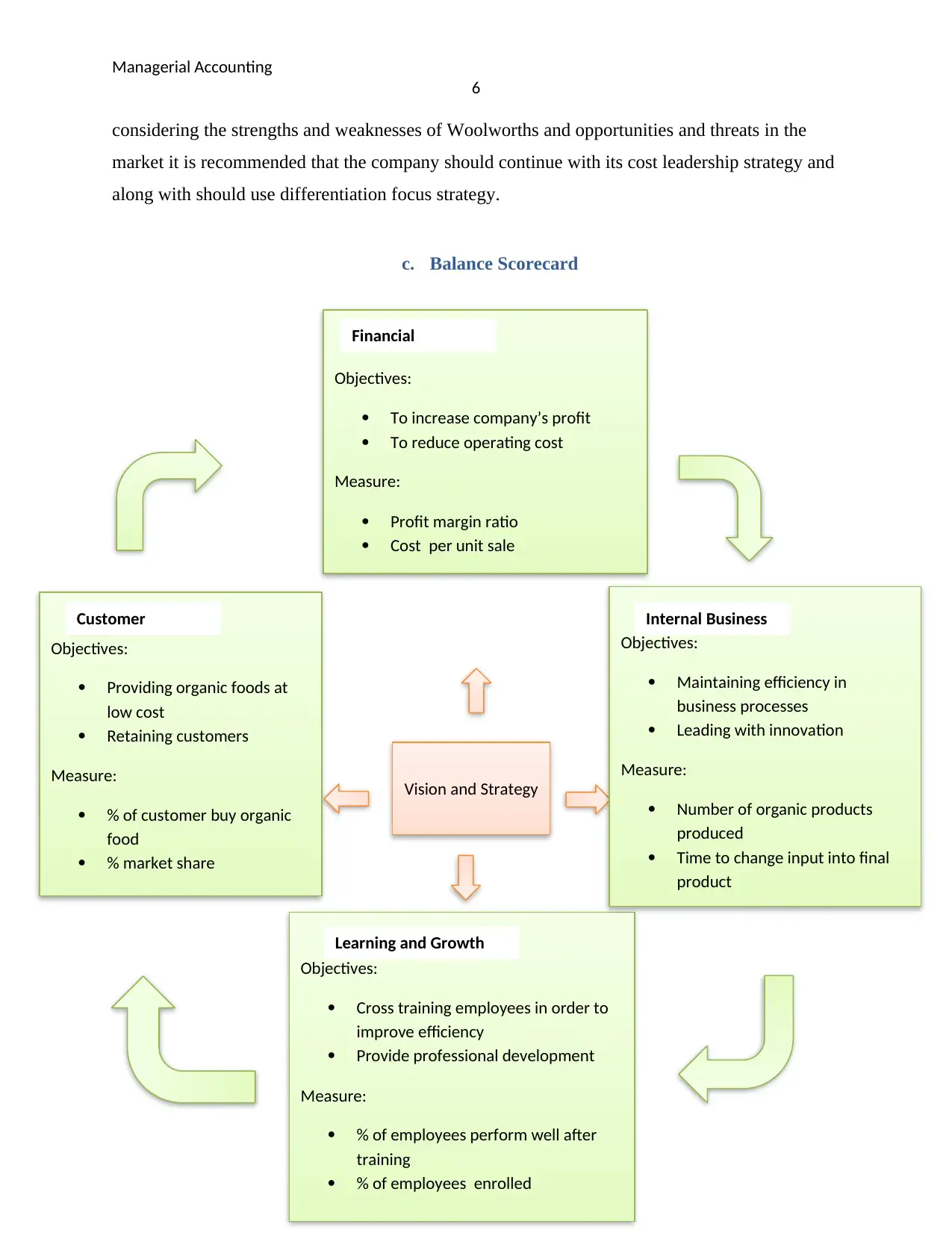
Managerial Accounting
6
considering the strengths and weaknesses of Woolworths and opportunities and threats in the
market it is recommended that the company should continue with its cost leadership strategy and
along with should use differentiation focus strategy.
c. Balance Scorecard
Vision and Strategy
Objectives:
Cross training employees in order to
improve efficiency
Provide professional development
Measure:
% of employees perform well after
training
% of employees enrolled
Objectives:
Providing organic foods at
low cost
Retaining customers
Measure:
% of customer buy organic
food
% market share
Objectives:
To increase company’s profit
To reduce operating cost
Measure:
Profit margin ratio
Cost per unit sale
Objectives:
Maintaining efficiency in
business processes
Leading with innovation
Measure:
Number of organic products
produced
Time to change input into final
product
Financial
Customer
Learning and Growth
Internal Business
6
considering the strengths and weaknesses of Woolworths and opportunities and threats in the
market it is recommended that the company should continue with its cost leadership strategy and
along with should use differentiation focus strategy.
c. Balance Scorecard
Vision and Strategy
Objectives:
Cross training employees in order to
improve efficiency
Provide professional development
Measure:
% of employees perform well after
training
% of employees enrolled
Objectives:
Providing organic foods at
low cost
Retaining customers
Measure:
% of customer buy organic
food
% market share
Objectives:
To increase company’s profit
To reduce operating cost
Measure:
Profit margin ratio
Cost per unit sale
Objectives:
Maintaining efficiency in
business processes
Leading with innovation
Measure:
Number of organic products
produced
Time to change input into final
product
Financial
Customer
Learning and Growth
Internal Business
Paraphrase This Document
Need a fresh take? Get an instant paraphrase of this document with our AI Paraphraser
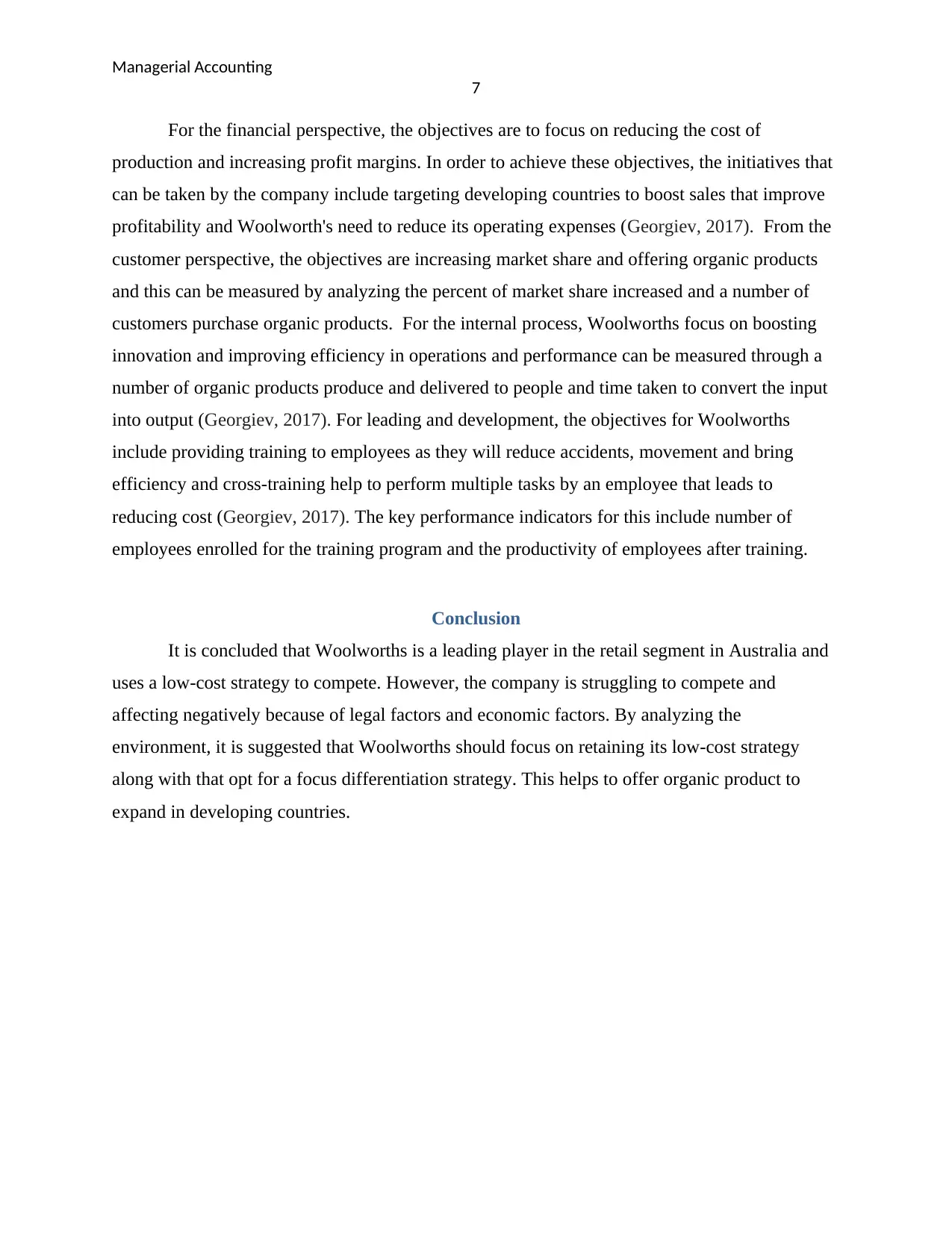
Managerial Accounting
7
For the financial perspective, the objectives are to focus on reducing the cost of
production and increasing profit margins. In order to achieve these objectives, the initiatives that
can be taken by the company include targeting developing countries to boost sales that improve
profitability and Woolworth's need to reduce its operating expenses (Georgiev, 2017). From the
customer perspective, the objectives are increasing market share and offering organic products
and this can be measured by analyzing the percent of market share increased and a number of
customers purchase organic products. For the internal process, Woolworths focus on boosting
innovation and improving efficiency in operations and performance can be measured through a
number of organic products produce and delivered to people and time taken to convert the input
into output (Georgiev, 2017). For leading and development, the objectives for Woolworths
include providing training to employees as they will reduce accidents, movement and bring
efficiency and cross-training help to perform multiple tasks by an employee that leads to
reducing cost (Georgiev, 2017). The key performance indicators for this include number of
employees enrolled for the training program and the productivity of employees after training.
Conclusion
It is concluded that Woolworths is a leading player in the retail segment in Australia and
uses a low-cost strategy to compete. However, the company is struggling to compete and
affecting negatively because of legal factors and economic factors. By analyzing the
environment, it is suggested that Woolworths should focus on retaining its low-cost strategy
along with that opt for a focus differentiation strategy. This helps to offer organic product to
expand in developing countries.
7
For the financial perspective, the objectives are to focus on reducing the cost of
production and increasing profit margins. In order to achieve these objectives, the initiatives that
can be taken by the company include targeting developing countries to boost sales that improve
profitability and Woolworth's need to reduce its operating expenses (Georgiev, 2017). From the
customer perspective, the objectives are increasing market share and offering organic products
and this can be measured by analyzing the percent of market share increased and a number of
customers purchase organic products. For the internal process, Woolworths focus on boosting
innovation and improving efficiency in operations and performance can be measured through a
number of organic products produce and delivered to people and time taken to convert the input
into output (Georgiev, 2017). For leading and development, the objectives for Woolworths
include providing training to employees as they will reduce accidents, movement and bring
efficiency and cross-training help to perform multiple tasks by an employee that leads to
reducing cost (Georgiev, 2017). The key performance indicators for this include number of
employees enrolled for the training program and the productivity of employees after training.
Conclusion
It is concluded that Woolworths is a leading player in the retail segment in Australia and
uses a low-cost strategy to compete. However, the company is struggling to compete and
affecting negatively because of legal factors and economic factors. By analyzing the
environment, it is suggested that Woolworths should focus on retaining its low-cost strategy
along with that opt for a focus differentiation strategy. This helps to offer organic product to
expand in developing countries.
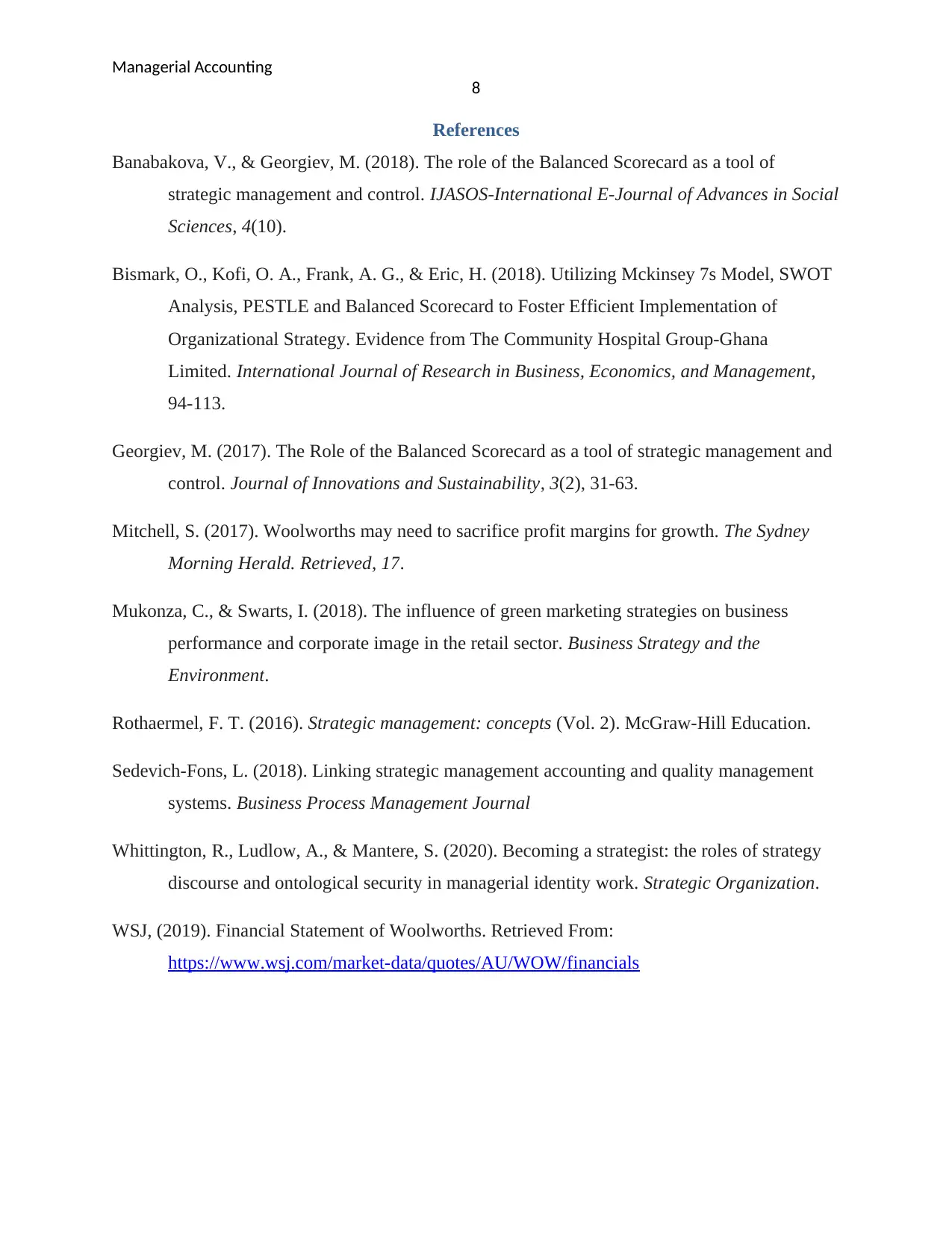
Managerial Accounting
8
References
Banabakova, V., & Georgiev, M. (2018). The role of the Balanced Scorecard as a tool of
strategic management and control. IJASOS-International E-Journal of Advances in Social
Sciences, 4(10).
Bismark, O., Kofi, O. A., Frank, A. G., & Eric, H. (2018). Utilizing Mckinsey 7s Model, SWOT
Analysis, PESTLE and Balanced Scorecard to Foster Efficient Implementation of
Organizational Strategy. Evidence from The Community Hospital Group-Ghana
Limited. International Journal of Research in Business, Economics, and Management,
94-113.
Georgiev, M. (2017). The Role of the Balanced Scorecard as a tool of strategic management and
control. Journal of Innovations and Sustainability, 3(2), 31-63.
Mitchell, S. (2017). Woolworths may need to sacrifice profit margins for growth. The Sydney
Morning Herald. Retrieved, 17.
Mukonza, C., & Swarts, I. (2018). The influence of green marketing strategies on business
performance and corporate image in the retail sector. Business Strategy and the
Environment.
Rothaermel, F. T. (2016). Strategic management: concepts (Vol. 2). McGraw-Hill Education.
Sedevich-Fons, L. (2018). Linking strategic management accounting and quality management
systems. Business Process Management Journal
Whittington, R., Ludlow, A., & Mantere, S. (2020). Becoming a strategist: the roles of strategy
discourse and ontological security in managerial identity work. Strategic Organization.
WSJ, (2019). Financial Statement of Woolworths. Retrieved From:
https://www.wsj.com/market-data/quotes/AU/WOW/financials
8
References
Banabakova, V., & Georgiev, M. (2018). The role of the Balanced Scorecard as a tool of
strategic management and control. IJASOS-International E-Journal of Advances in Social
Sciences, 4(10).
Bismark, O., Kofi, O. A., Frank, A. G., & Eric, H. (2018). Utilizing Mckinsey 7s Model, SWOT
Analysis, PESTLE and Balanced Scorecard to Foster Efficient Implementation of
Organizational Strategy. Evidence from The Community Hospital Group-Ghana
Limited. International Journal of Research in Business, Economics, and Management,
94-113.
Georgiev, M. (2017). The Role of the Balanced Scorecard as a tool of strategic management and
control. Journal of Innovations and Sustainability, 3(2), 31-63.
Mitchell, S. (2017). Woolworths may need to sacrifice profit margins for growth. The Sydney
Morning Herald. Retrieved, 17.
Mukonza, C., & Swarts, I. (2018). The influence of green marketing strategies on business
performance and corporate image in the retail sector. Business Strategy and the
Environment.
Rothaermel, F. T. (2016). Strategic management: concepts (Vol. 2). McGraw-Hill Education.
Sedevich-Fons, L. (2018). Linking strategic management accounting and quality management
systems. Business Process Management Journal
Whittington, R., Ludlow, A., & Mantere, S. (2020). Becoming a strategist: the roles of strategy
discourse and ontological security in managerial identity work. Strategic Organization.
WSJ, (2019). Financial Statement of Woolworths. Retrieved From:
https://www.wsj.com/market-data/quotes/AU/WOW/financials
⊘ This is a preview!⊘
Do you want full access?
Subscribe today to unlock all pages.

Trusted by 1+ million students worldwide
1 out of 9
Related Documents
Your All-in-One AI-Powered Toolkit for Academic Success.
+13062052269
info@desklib.com
Available 24*7 on WhatsApp / Email
![[object Object]](/_next/static/media/star-bottom.7253800d.svg)
Unlock your academic potential
Copyright © 2020–2025 A2Z Services. All Rights Reserved. Developed and managed by ZUCOL.





